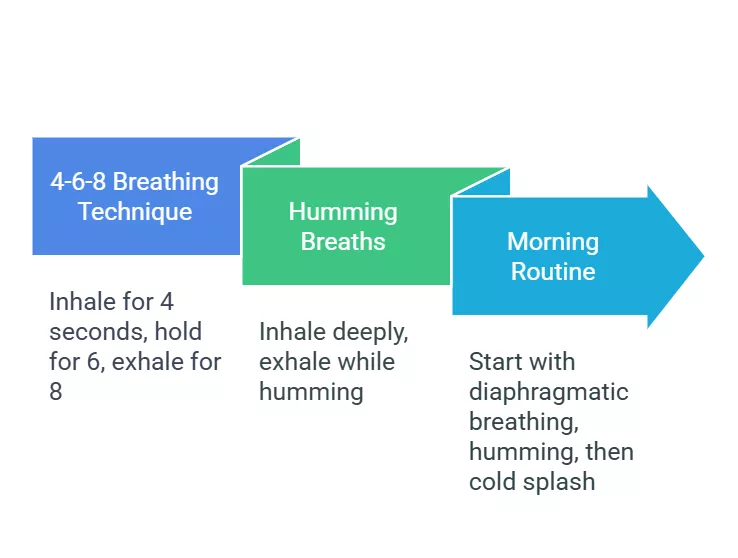You’ve probably heard that taking slow, deep breaths can calm you down. But did you know this simple act could also help lower your blood pressure? The secret lies in a fascinating part of your body called the vagus nerve—a long, wandering nerve that acts like a remote control for your heart, lungs, and stress levels.
In this article, we’ll break down how deep breathing “talks” to your vagus nerve, why this matters for blood pressure, and how you can use this science-backed trick to support your health. Plus, if you’re new to deep breathing, don’t miss our step-by-step guide to deep breathing exercises for practical tips.
What Is the Vagus Nerve? (And Why Should You Care?)
Let’s start with the basics. The vagus nerve is the longest nerve in your body, stretching from your brainstem down to your abdomen. Think of it as your body’s built-in “chill-out cable.” It’s part of the parasympathetic nervous system—the system that helps you relax, digest food, and recover after stress.
When your vagus nerve is active, it sends signals to:
- Slow your heart rate
- Relax blood vessels (which lowers blood pressure)
- Reduce inflammation
- Calm your mind
On the flip side, when you’re stressed, your “fight-or-flight” system takes over. Your heart races, blood pressure spikes, and your body prepares for danger. Deep breathing flips the switch back to “rest-and-digest” mode by stimulating the vagus nerve.
How Deep Breathing Awakens Your Vagus Nerve

Not all breathing is created equal. Shallow, quick breaths (like when you’re anxious) do little for the vagus nerve. But slow, deep, diaphragmatic breathing—the kind where your belly rises—triggers a powerful response.
Here’s how it works:
- Diaphragmatic Breathing Stretches the Vagus Nerve
When you breathe deeply, your diaphragm (the muscle below your lungs) moves up and down. This movement gently massages the vagus nerve, “turning it on” like a light switch. - Slow Breaths = Vagus Nerve Activation
Studies show that breathing at a rate of 5–6 breaths per minute (about 5 seconds inhale, 5 seconds exhale) maximizes vagus nerve stimulation. This rhythm syncs with your body’s natural relaxation response. - The Nitric Oxide Bonus
Deep nasal breathing releases nitric oxide, a molecule that relaxes blood vessels. Combine this with vagus nerve activation, and you’ve got a double whammy for lowering blood pressure.
The Blood Pressure Connection
High blood pressure is often called the “silent killer” because it damages your heart and arteries over time. While medication helps, lifestyle changes like deep breathing can play a big role. Here’s how the vagus nerve ties into this:
- Relaxes Blood Vessels
A stimulated vagus nerve tells blood vessels to widen (vasodilation), which lowers resistance and eases pressure on your heart. - Slows Heart Rate
Ever noticed your heart pounding when you’re stressed? The vagus nerve counters this by reducing heart rate, which directly impacts blood pressure. - Reduces Stress Hormones
Chronic stress floods your body with cortisol and adrenaline, which raise blood pressure. Activating the vagus nerve dials down these hormones.
Did You Know?
A 2025 study in the Journal of Hypertension found that participants who practiced slow breathing for 10 minutes daily lowered their systolic blood pressure (the top number) by an average of 10–15 points after 8 weeks.
How to “Hack” Your Vagus Nerve with Breathing
Ready to put this into action? Here’s a simple routine to stimulate your vagus nerve and support healthy blood pressure:
The 4-6-8 Breathing Technique
- Sit comfortably, close your eyes, and relax your shoulders.
- Inhale deeply through your nose for 4 seconds (let your belly expand).
- Hold your breath for 6 seconds.
- Exhale slowly through your mouth for 8 seconds.
- Repeat for 5–10 minutes daily.
Why It Works: The long exhale triggers stronger vagus nerve activity.
Humming Breaths
Humming creates vibrations that directly stimulate the vagus nerve. Try this:
- Inhale deeply for 4 seconds.
- Exhale slowly while humming “OM” or your favorite tune.
- Repeat 5–7 times.
Morning “Vagus Wake-Up” Routine
Before checking your phone or coffee, try this:
- 2 minutes of diaphragmatic breathing (focus on belly movement).
- 1 minute of humming breaths.
- Finish with a cold splash of water on your face (another vagus nerve booster!).

The Science Behind It All
Still skeptical? Let’s look at the research:
- A 2024 study found that paced breathing (6 breaths per minute) increased vagal activity by 30% in adults with hypertension.
- The American Heart Association recognizes slow breathing as a Class IIa recommendation (moderate evidence) for lowering blood pressure.
- MRI scans show that deep breathing increases activity in brain regions connected to the vagus nerve.
When to Practice for Best Results
Consistency matters more than perfection. Aim for:
- Morning: Start your day with 5 minutes of breathing to set a calm tone.
- Stressful Moments: Use 1–2 minutes of deep breathing to reset during tension.
- Before Bed: Lower nighttime blood pressure with a 10-minute session.
A Word of Caution
While deep breathing is safe for most people, consult your doctor if you have:
- Severe lung conditions (e.g., COPD)
- Very low blood pressure
- Dizziness during breathing exercises
Final Thoughts: Your Body’s Natural Pressure Valve
Your vagus nerve is like a bridge between your mind and body. By practicing deep breathing, you’re not just lowering blood pressure—you’re training your body to handle stress better, sleep deeper, and feel more balanced.
If you’re new to this, start small. Even 3–5 minutes daily can make a difference. Pair your breathing practice with other heart-healthy habits like walking, hydration, and mindful eating.
And remember, this isn’t a replacement for medical treatment—it’s a tool to enhance your health.
Your Turn: Try the 4-6-8 technique right now. Close your eyes, take a slow breath in… and let the exhale carry tension away. Your vagus nerve—and your heart—will thank you!
